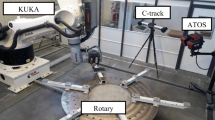Abstract
Industrial robots are used in a great variety of applications for handling, welding and milling operations. They represent a cost-saving and flexible alternative for machining applications. A reduced pose and path accuracy, especially under process force load due to the high mechanical compliance, restrict the use of industrial robots for further machining applications. Test results showed that these deviations range up to 0.6 mm. In this paper, a method is presented to determine the resulting path deviation of the robot under process force by using a structured light scanner. The obtained data is compared with the CAD (Computer Aided Design) data of the machined part within a developed software module. Additionally, the developed module provides functions for manipulation, registration of STL (Surface Tessellation Language) surface point clouds and a postprocessor for program translation. The comparison is performed using a dexel discretization of each data set. Based on this comparison the robot path is adapted to improve the machining quality. This method can be applied to 3- and 5-axis machining operations. The results show that the deviation can be reduced to 0.1 mm.













Similar content being viewed by others
References
Xiao W, Strauß H, Loohß T, Hoffmeister H-W, Hesselbach J (2011) Closed-form inverse kinematics of 6R milling robot with singularity avoidance. Prod Eng Res Dev 5(1):103–110
Weigold M (2008) Kompensation der Werkzeugabdrängung bei der spanenden Bearbeitung mit Industrierobotern. Dissertation, RWTH Aachen (Schriftenreihe des PTW), zugl. Shaker Verlag, Aachen
Abele E, Bauer J, Pischan M, Friedmann M, Hemker T, Stryk OV (2010) Prediction of the tool displacement for robot milling applications using coupled models of an industrial robot and removal simulation, CIRP 2nd International Conference Process Machine Interactions, Vancouver, Canada
Stautner M (2005) Simulation und Optimierung der mehrachsigen Fräsbearbeitung, Dissertation, Universität Dortmund, Vulkan Verlag, Essen, 2005
Gühring J (2002) 3D- Erfassung und Objektrekonstruktion mittels Streifenprojektion, Dissertation, Universität Stuttgart
Bertagnolli F (2006) Robotergestützte automatische Digitalisierung von Werkstückgeometrien mittels optischer Streifenprojektion, Dissertation, RWTH Aachen, Shaker Verlag
Abele E, Bauer J (2010) Kamerabasierte Bahnkorrektur für das Fräsen mit Industrierobotern, wt Werkstattstechnik online Jahrgang 100 H9, S705–S709
Author information
Authors and Affiliations
Corresponding author
Rights and permissions
About this article
Cite this article
Abele, E., Schützer, K., Bauer, J. et al. Tool path adaption based on optical measurement data for milling with industrial robots. Prod. Eng. Res. Devel. 6, 459–465 (2012). https://doi.org/10.1007/s11740-012-0383-9
Received:
Accepted:
Published:
Issue Date:
DOI: https://doi.org/10.1007/s11740-012-0383-9




